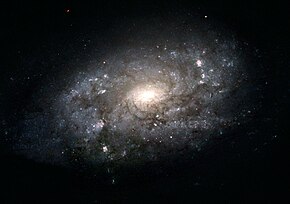NGC 3949
Appearance
| NGC 3949 | |
|---|---|
 A Hubble Space Telescope (HST) image of NGC 3949 | |
| Observation data (J2000 epoch) | |
| Constellation | Ursa Major |
| Right ascension | 11h 53m 41.4s[1] |
| Declination | +47° 51′ 31.6″[1] |
| Redshift | 800 ± 1 km/s[1] |
| Distance | 50 million light-years[citation needed] |
| Apparent magnitude (V) | 11.5[1] |
| Characteristics | |
| Type | SA(s)bc[1] |
| Size | 50,000 ly (diameter) |
| Apparent size (V) | 2′.9 × 1′.7[1] |
| Other designations | |
| UGC 6869,[1] PGC 37290[1] | |
NGC 3949 is an unbarred spiral galaxy in the constellation Ursa Major. It is believed to be approximately 50 million light-years away from the Earth.
Supernova
The type II supernova SN 2000db is the only supernova that has been observed within NGC 3949.[1]
Environment
NGC 3949 is a member of the M109 Group, a group of galaxies located in the constellation Ursa Major that may contain over 50 galaxies. The brightest galaxy in the group is the spiral galaxy M109.[2][3][4]
References
- ^ a b c d e f g h i "NASA/IPAC Extragalactic Database". Results for NGC 3949. Retrieved 2006-11-16.
- ^ R. B. Tully (1988). Nearby Galaxies Catalog. Cambridge: Cambridge University Press. ISBN 0-521-35299-1.
- ^ A. Garcia (1993). "General study of group membership. II - Determination of nearby groups". Astronomy and Astrophysics Supplement. 100: 47–90. Bibcode:1993A&AS..100...47G.
- ^ G. Giuricin; C. Marinoni; L. Ceriani; A. Pisani (2000). "Nearby Optical Galaxies: Selection of the Sample and Identification of Groups". Astrophysical Journal. 543 (1): 178–194. arXiv:astro-ph/0001140. Bibcode:2000ApJ...543..178G. doi:10.1086/317070.
